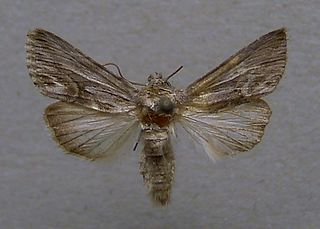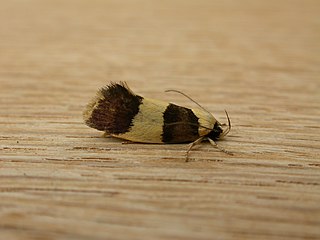
Apamea crenata, known as the clouded-bordered brindle, is a moth in the family Noctuidae. It is distributed throughout the Palearctic realm. In the North it crosses the Arctic Circle, in the Mediterranean it is found only in cool locations and mountains avoiding very hot areas. In the Alps, it rises to an altitude of about 2000 metres.

Lozotaenia forsterana is a moth of the family Tortricidae. It is found in Europe and across the Palearctic.

Anania crocealis is a species of moth of the family Crambidae. It was described by Jacob Hübner in 1796 and is found in Europe.

Carcina quercana is a species of moth of the family Depressariidae. It is found in Europe. It has been introduced recently in North America, British Columbia and western Washington. It is occasionally known by several common names including oak lantern, long-horned flat-body, and oak-skeletonizer moth.

Mesapamea secalis, the common rustic, is a moth of the family Noctuidae. The species was first described by Carl Linnaeus in his 1758 10th edition of Systema Naturae. It is found in Europe, north-west Africa, Turkey and northern Iran.

Grammodes stolida, the geometrician, is a moth of the family Erebidae. The species was first described by Johan Christian Fabricius in 1775. It is found in Africa, southern Europe, most of Asia and Australia. It migrates to central and northern Europe as far north as England, Denmark and Finland.

Agrotis trux, the crescent dart, is a moth of the family Noctuidae. The species was first described by Jacob Hübner in 1824. It has a circum-Mediterranean distribution and is found along the coasts of France, Ireland, England, southern Europe, Algeria, Syria, Iraq, Iran, southern Russia and the Arabian Peninsula. In Africa, it is found as far south as South Africa.

Calophasia platyptera, the antirrhinum brocade, is a moth of the family Noctuidae. The species was first described by Eugenius Johann Christoph Esper in 1788. It is found in Europe, the Near East, the western Sahara, Morocco, Algeria and Tunisia.
Batrachedra epixantha is a species of moth of the family Batrachedridae. It is found in Australia.

Telecrates laetiorella is a moth of the family Xyloryctidae. It is known from the Australian Capital Territory, New South Wales, Queensland, South Australia and Victoria.

Depressaria daucella is a moth of the family Depressariidae. It is found in most of Europe, except most of the Balkan Peninsula. It is also found in North America.

Bucculatrix demaryella is a moth of the family Bucculatricidae. The species was first described by Philogène Auguste Joseph Duponchel in 1840. It is found in most of Europe, Russia and Japan.

Metzneria metzneriella is a moth of the family Gelechiidae. It is widely distributed throughout Europe, as well as Turkey and southern Siberia. The habitat consists of dry pastures and calcareous soils.
Filodes xanthalis is a moth in the family Crambidae. It was described by George Hampson in 1898. It is found on New Guinea.
Salbia thyrsonoma is a moth in the family Crambidae. It is found in Bolivia.
Syllepte bipartalis is a moth in the family Crambidae. It was described by George Hampson in 1898. It is found in Pulo Laut, Indonesia.
Tyspanodes creaghi is a moth in the family Crambidae. It was described by George Hampson in 1898. It is found on Borneo and in Papua New Guinea and Australia, where it has been recorded from Queensland.

Auzata minuta is a moth in the family Drepanidae. It was described by John Henry Leech in 1898. It is found in the Chinese provinces of Hubei, Sichuan, Guizhou, Yunnan, Zhejiang and Shanxi.
Gonioma hypoxantha is a moth in the family Xyloryctidae. It was described by Oswald Bertram Lower in 1894. It is found in Australia, where it has been recorded from Queensland.
Enchocrates glaucopis is a moth in the family Depressariidae. It was described by Edward Meyrick in 1883. It is found in Australia, where it has been recorded from the south-east of the country.













